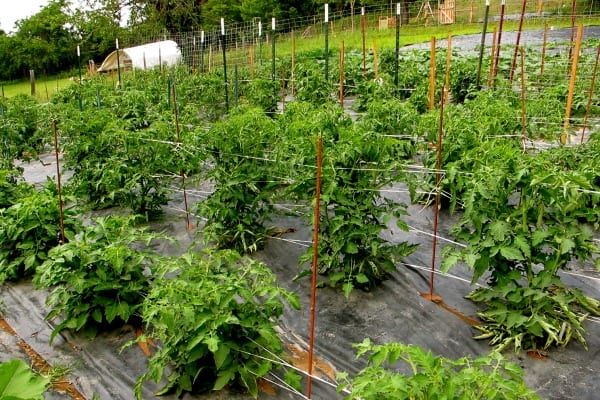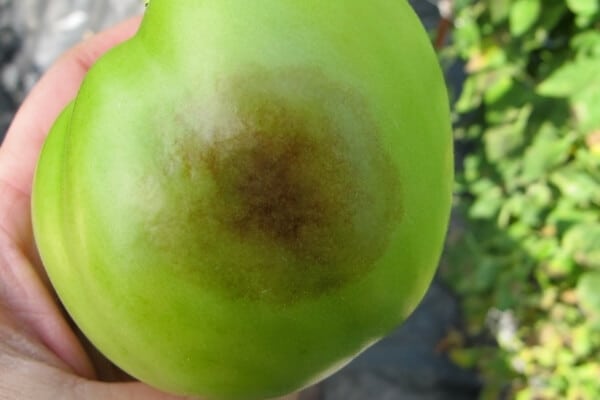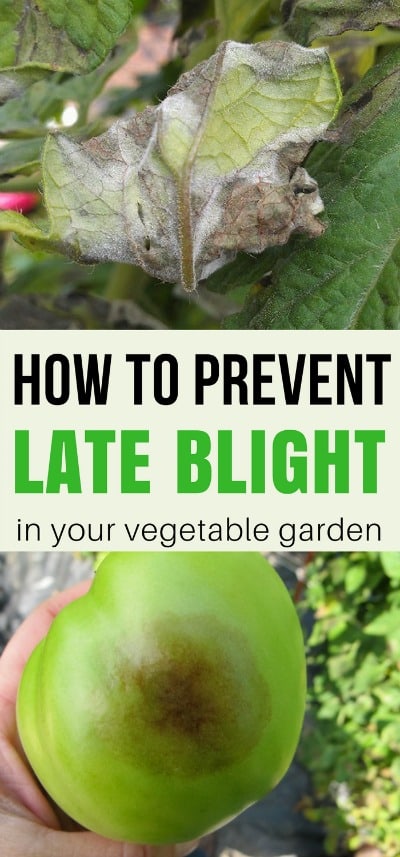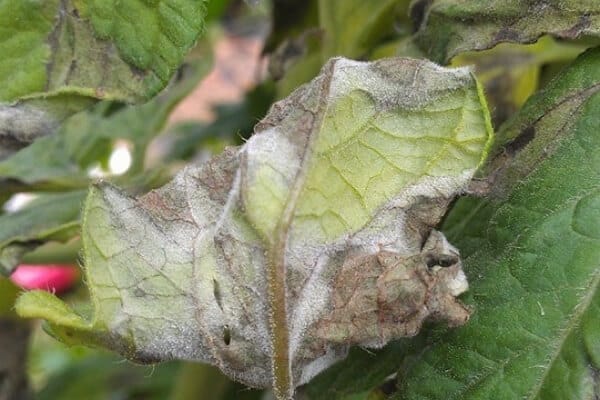Late blight can devastate your backyard garden. Learn how to identify late blight and how to prevent it from taking over your garden.
3 years ago I had big plans. I spent hours planting over 300 tomato seeds. I watered, I turned, I transplanted. I spent a week digging 300 holes and putting them into the ground.
This site contains affiliate links. If you make a purchase using one of these links, I may earn a commission. Please see my disclosure page for more information about cookies collected and our privacy policy.
I spent even more hours pinching off suckers and winding twine around the plants to tie them to their stakes. They were growing, heavy with green fruits and so close to turning red.
Aren’t they beautiful?
That’s when I found it. It started as black spots on the leaves and fuzzy white growth on the underside. We’d fought bacterial spot before. Early blight even. But this was different. I walked the garden and found more plants along the row- with blackened stems and even some of the fruits had a bruised look about it.
I knew what it was, but I snapped some pictures and sent them to my husband and sat down to Google. And my heart sank.
Late Blight.
I was devastated. We dug up all the plants we could find with signs. We started spraying the remaining tomatoes with an organic copper fungicide. But one by one my plants fell. Over the course of a month every. single. plant. was infected. We were lucky to get a few early tomatoes first, but all hopes of canned sauce were gone.
I wouldn’t wish that on any gardener! So what can you do to prevent late blight from destroying your garden? First let’s talk about what it is and how to spot it.
Signs of Late Blight
Late blight is not like other diseases that strike your garden. Most will cause a reduction of harvest, but not affect the entire crop. Late Blight, however, will take down the entire plant- and it is highly contagious and spreads easy. This means one plant will most likely turn to 2, which turns to 3, and so on and so on.
Technically speaking, Late blight is a fungus, Phytophthora infestans, to be exact. It spreads easily on the wind through spores and can travel quite a ways to settle on your plants. It affects both tomatoes and potates (Irish potato famine!). So be on the lookout on both crops.
Plants should be destroyed to that no infected plant matter remains in your garden, on your soil, or in your compost heap. We bagged ours up in trash bags. The good news is that late blight won’t live in your soil or on your tomato cages…but make sure you get all roots, stems, leaves, and potatoes out of the ground.
- Cooler, wetter weather will spread the disease quickly. It provides optimum conditions for blight to spread.
- The leaves are the first infected- usually lower on the plants. You will see blackened areas over the leaves. One of the easily identifiable signs is the white, fuzzy, fungal growth on the underside of these leaves.
- Stems will also start to blacked in random spots- usually at a joint.
- Fruits are usually the last to show signs- green fruits will become brown in areas and turn completely brown/black as it progresses.
Make your homestead dreams come true! The Homestead Goal Planner will help you prioritize your life and your homestead goals and keep you on track with good planning practices. After all, goal with out a plan is just a dream!
How to Prevent Late Blight in Your Garden
That’s the way it is with most things, right? It is better to prevent late blight than to try and treat and save an infected area. So how can you prevent late blight?
Plant blight-resistant varieties. There are a few heirloom tomatoes that seem to have some natural resistance as well as some hybrids that can fight late blight.
Pay attention to proper spacing. I think one of the reasons my plants were so hard it was that I planted them too close together in order to fit them all in, that put together with a wet and cool June, gave me the perfect recipe for blight. Proper spacing will allow your tomatoes to dry faster and allow more air circulation.
Here’s my guide on correct garden spacing. It also includes a chart of recommend space for common vegetables.
Water the roots, not the leaves. This should be a rule for all plants. Wet conditions can breed a lot of disease- so keep the water on the ground and not on the leaves.
Practice good crop rotation so that your tomatoes and potatoes are not planted in the same soil year after year. This will reduce the risk of plant matter accidentally being left from previous years- which may have spores still living on them.
Solarize your soil prior to planting.
Use organic sprays BEFORE you see signs of blight. Serenade is a biological fungicide that can help prevent late blight- along with organic copper fungicide. Spray to prevent, not treat.
What to do if Late Blight Strikes
In all my years gardening in East Tennessee, I never saw late blight. Now, living in Western North Carolina, it seems that it’s not a matter of if, but when we will see late blight. We live in an area that has a lot of commercial tomato farms- we live less than a mile from about 3 fields! So spores are on the wind- and without a hot dry summer- we fight the battle every year.
If you find yourself with infected plants, here’s what you should do.
Pull up infected plants immediately. The entire plant. Bag it up and set it out for the trash pick up.
If you aren’t already spray products like Serenade or an organic copper fungicide on the remaining plants.
Contact your local extension agent to report the infection. Remember late blight is extremely contagious and if you allow it to go rampant in your garden you are risking infecting your neighbor’s gardens as well.
Don’t give up. Believe me, I know how devastating it is to loose you garden to a disease like this. Don’t give up. Rebound quickly and plant something in its place. A nice fall crop of brassicas or greens, beans, or other veggies that are good for the season.
Plan ahead for next year. Prepare your soil ahead of time and plant a good variety of plants- including early varieties that you can harvest before any chance of late blight occurs.
My Yearly Gardening Planner is perfect for keeping track of everything- from your seed inventory to planting dates to disease and pest problems.
The year we pulled up all of our plants, we also brought in a few hundred pounds of green tomatoes to attempt to ripen in our basement. Most of them succumbed to late blight and rotted before they ripened.
And even though it was devastating, we continue to plan tomatoes every year- we just have to be extra careful and use as many prevention techniques as possible. Have you dealt with late blight in your garden? Let me know your experience with it in the comments!







I moved back to MN from AZ early this spring and worked constantly on my tomatoes. We had a rather high amount of precipitation but it would come in spread out huge amounts. 3 inches here, four there and even a 6.5 inch day. …but there were many dry days in between. Well, I left during another soaker to go see the eclipse in OR and I came back to a black nightmare. It was everywhere? I hadn’t even noticed it 7 days earlier. I blamed my boyfriend at first until I discovered this awful “late blight” fungus online. Do I have to apologize? Lol. Ok so now I rid the plants completely. How do you get out all of the root system?
I’m thinking of moving my vegi garden and planting strawberries in the old garden while late blight bother strawberries?
which fungicide is used to treat late blight not to prevent.